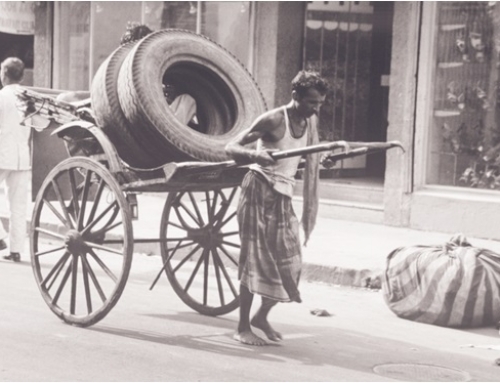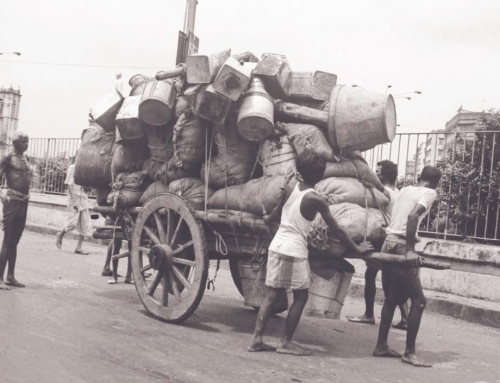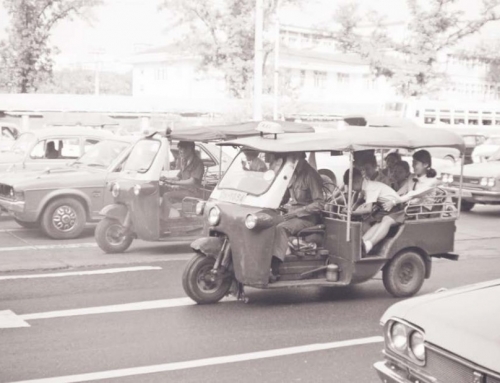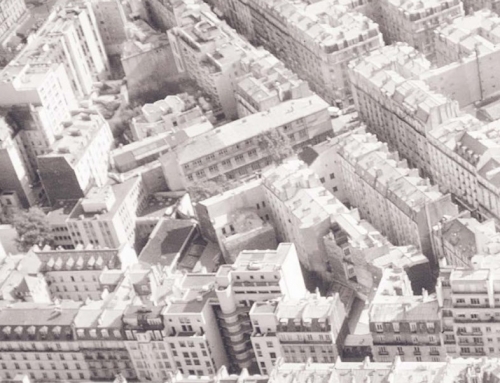The question of what constitutes “urbanism” has vexed thinkers for as long as cities have been written about, but few have contributed more profound insights than Mel Webber. Over his fifty-year career, he distinguished himself as a teacher, researcher, builder of institutions, editor, and professional planner, but it is as a theorist and analyst of deep urban social changes that he may have made his greatest contribution. His theoretical insights have shaped the development of many ideas in planning, transportation, and spatial analysis, but none has had more influence than his idea of the “nonplace urban realm.”
Webber’s papers, “Order in Diversity: Community Without Propinquity” and “The Urban Place and the Nonplace Urban Realm,” published in 1963 and 1964 respectively, challenged the foundations of urban studies and planning of the time. The fundamental view of urban development then was rooted in the concept of place—the physically based, economic, social aggregate that constitute a city. For urban planners, geographers, and transportation engineers, place was at the center of their work. Their job was to understand the city and its patterns of growth and change, and to plan and respond effectively. Webber had been deeply immersed in this point of view, both as a student in a new professional planning program at the University of California, Berkeley, and as a young professional engaged in the development of BART, the first new major rapid transit system in the US in decades.
However, when he joined the faculty in the Department of City and Regional Planning at UC Berkeley, he began to rethink the orthodoxy of the time. In lengthy discussions with his colleague, the sociologist Donald Foley, and through an extended network—one not dissimilar to those he would come to see as operating in nonplace realms—Webber reassessed the nature and future of urban development. He recognized what few had then seen, but many would see much later: that the changes in the speed and nature of communications were fundamentally changing the definition of “city.” For companies and other organizations, the constraints of location seemed to be breaking down once they could locate and maintain their market contacts outside the traditional city. In Mel’s view, the city itself was a giant communications mechanism (he described it as a switchboard), which was now extending to the entire world.
In Mel’s view, the city was a giant communications mechanism (he described it as a switchboard), which was extending to the entire world.
But there were also other implications of the development of communications technologies. For the huge majority of people, the world had been confined to one place, encompassing family, tribe, social interaction, work, and political life, but the transformation of communications and transportation was about to break those bounds. This change would not just be physical, with people traveling more, but it would affect patterns of mind and expectations in deep ways. How these would change is still open to debate; Mel’s work did not answer all the questions it raised, but it established a framework for discussion. There can be no doubt that massive urban agglomerations will dominate the way in which the world’s population will live in the coming century, although this was not fully evident at the time that Mel was writing.
Nonetheless, in the early 1960s, American cities were clearly undergoing massive change. Suburbanization, already in place since the 1920s, had accelerated in the post-World War II period, reflecting rising incomes, government housing policy supporting home ownership, and increased mobility. Industries and white populations were leaving the old central cities, which were increasingly home to impoverishment and ghettoization of African Americans. The outpouring of rage and frustration manifested in the riots in Detroit, Los Angeles, and other cities after 1963 was about to shock the American psyche and lead to huge changes. Forty years later, many of these problems remain unresolved, despite a large number of efforts to address them. We have seen government intervention replaced by market-based solutions; the “Great Society” and the “War on Poverty” have given way to housing vouchers and welfare reform. But the underlying problems of inequality and the inability of some groups to fully participate in the American economy and society are still with us.
Those problems seem to be stubbornly place-bound: segregation and bad schools are spatially defined. Furthermore, the consequences of the loosening spatial bonds that Mel identified are now threatening the livelihood and peace of mind of wider populations. Formerly stable industries have responded to global competition by outsourcing and plant closures that displace their workers. A new wave of immigrants creates other direct threats to current workers. Paradoxically, along with continuing suburbanization, we see simultaneous evidence of regeneration in central cities: downtown development based on entertainment, high technology specialization, cultural tourism, and a resurgence of higher-density living. Finally, since Webber’s essays were written, there has been a huge transformation in social perceptions of the environment and its importance. It may be a good time, therefore, to reexamine Webber’s ideas.
Reading Mel Webber’s essays forty years on, one cannot help but be struck both by their prescience and by the fact that they are rooted in their time, the late 1950s and early 1960s. Further, it is clear that at that time Webber was deeply engaged in a dialogue about cities, planning, and metropolitanism with colleagues near and far, many of whom would eventually find themselves also at UC Berkeley. Planners were trying to understand the objectives and meaning of their work in a rapidly changing world.
It is in his prescient insights into urban life and its changes that the essays have their real power. A popular view of his notions of the nonplace urban realm and community without propinquity is that they note the vaporization of the traditional meaning of “city” into networks of relationships at varying distances, perhaps privileging elites. His image of a biochemist engaged in projects spanning the globe while simultaneously working in his laboratory was a powerful one, rooted in the university itself. Memorable though this is, it does not begin to encompass the intellectual program that Webber was setting forth. He was using the idea of non-propinquity as one element in a larger effort to recast our understanding of the nature of urban life. He sought to shift the focus of attention from place to connectivity, arguing that cities should be seen, in effect, as giant switchboards, and that to understand them we should be trying to measure and plan for the communications embedded in them. Again and again, he asserts that accessibility is the key to the existence of cities, and that with increasing accessibility the city itself becomes transformed from a place into a web of interactions at varying geographic scales. He saw urban realms as manifestations of “interest communities” that exist at varying scales, from the local to global, with no distinct boundaries, and with an increasing tendency to grow in geographic scale as communications continue to improve.
Identifying and describing networks one by one turns out to be a lot easier than measuring their aggregate effect and influence, as pointed out by Peter Hall and Kathy Pain in 2006. Nonetheless, Webber was perhaps the first scholar in planning to enunciate an alternative to place both as the basis for defining the object of planning itself and as a more powerful paradigm for planning practice.
A second aspect of the essays is Webber’s insistence that the dominant role of accessibility would inexorably lead to low-density, widely spread new kinds of cities and of urban living. In this, he stood against conventional planning thought of the time, not just in asserting that attempts to maintain dense cities were unrealistic, but in defending suburbia as a manifestation of people’s preferences. In so doing, he established the initial basis for a counter-orthodoxy that has become very influential.
Another aspect of Webber’s essays also deserves note. In his concluding summary to Explorations into Urban Structure, Jack Dyckman observes that Webber’s contribu-
tion exemplifies the entry of social science into planning. That was indeed a major impulse at the time. Although the essays themselves are discursive and wide-ranging, part of their effect is, in Dyckman’s words, to fashion “a noose which they slip over the long-held planning simplification-of-the-goal question.” Mel did this by raising issues about the fundamental nature of urban space and the processes of urban growth that had to be resolved by empirical research.
Of course, Mel missed some very important things too. In line with conventional thinking of his time, perhaps excepting followers of Patrick Geddes, Webber saw the environment purely in terms of human use. At the time of his writing, planners emerging from the Great Depression and the New Deal were interested in resource use and conservation, but not in ecology. The environmental movement and its attendant legislation were nascent in the early 1960s, and their subsequent influence on suburban growth has been mixed. If global warming does change the dominant patterns of development, it will have to be by virtue of an overwhelming imperative that can trump the forces that Webber described. Sustainability has been presented as that imperative, but it is not yet sufficiently grounded.
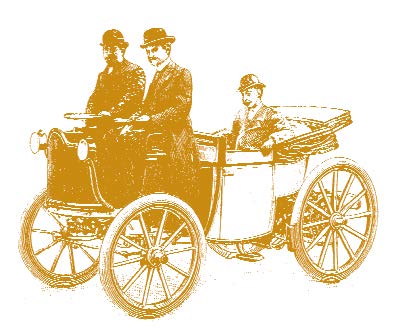 Webber’s essays did not anticipate the rise of localism and opposition to planning that has resulted in community development becoming a major part of the field. While he did not assert that central cities would wither away, the implication that they would is clear. That has not happened, even though central cities have experienced population decline. In reality, for many cities there has been a renaissance as communication centrality and amenity have grown. Webber himself noted this in a later essay.
Webber’s essays did not anticipate the rise of localism and opposition to planning that has resulted in community development becoming a major part of the field. While he did not assert that central cities would wither away, the implication that they would is clear. That has not happened, even though central cities have experienced population decline. In reality, for many cities there has been a renaissance as communication centrality and amenity have grown. Webber himself noted this in a later essay.
Perhaps the most interesting aspect of urban history subsequent to Webber’s papers has been the continuing dominance of major world city centers. While affluent people in high-income countries seek low-density, rural lifestyles, albeit often in the form of second homes, the conjunction of world population growth with rising incomes and productivity has generated an astonishing explosion of cities in developing countries. The skyscrapers of Shanghai and Mumbai seem to call Webber’s insights into question. In fact, of course, they are precisely manifestations of the broader webs of relations that he predicted. However, he did not foresee the continuing power of face-to-face communication and the necessity for close-by ancillary activities. Looking more closely at cities in China and India, we can see the desire for suburban lifestyles emerging, but whether it is sustainable except for a narrow group of elites may be in question.
To conclude, how might we assess Mel’s remarkable essays? Without doubt, they have deeply influenced thinkers and researchers in planning over the past forty years. They continue to be seminal and relevant at a time when the vision of cities as networks is immensely popular, especially in the work of Manuel Castells. The continuing growth of suburbia and of automobile dominance also seems to bear out Mel Webber’s vision of what was important in shaping urban growth in the 20th century. Reading current advocates of the “New Suburbanism” such as Joel Kotkin, one can see Webber’s insights translated into an ideological form that he would probably deplore as much as he deplored ideological arguments for urban constraint. Even so, the currency of those arguments cannot be denied. At the same time, the force of arguments against dispersion has not diminished; efforts like that of New Urbanism to build high-density settlements that are not automobile dependent are probably flourishing more now than at any time in three decades. If these streams converge, we may witness an historic compromise.
In sum, the innovation and insight of Webber’s nonplace essays still stands up to close examination forty years on. They marked the fertile beginning of a career that has shaped much of what city and transportation planning have become. And they still stand as documents that exemplify both the best of planning thought in their time, and the power of a remarkable intellect to see the world evolving.


